Some links may be affiliate links. I may get paid if you buy something or take an action after clicking one of these.
It’s time to talk about jaw distraction!
My daughter Josephine was born with Pierre Robin Sequence, or PRS. (You can read my brief explanation of Pierre Robin Sequence in my blog post What Is Pierre Robin Sequence? Josie’s Journey, Part 1.) When I was first told that Josie had PRS, I had a mile-long list of questions and worries. And of course the question at the top of my list was, how do we fix it?
The answer, in Josie’s case, was mandibular (jaw) distraction.
What Is Jaw Distraction?
Jaw distraction is basically the process of using hardware, attached surgically to the baby’s jaw, to move the chin forward gradually. By moving the chin forward, the surgeon makes space in the mouth for the baby’s tongue, so that the tongue is not pushed back into the airway. It’s a technique that can really help PRS babies to breathe more easily without a tracheostomy.
Josie’s surgeon made two small incisions on each side of her jaw, then cut her jaw bones and attached distraction hardware directly to the bones. The only parts of the hardware that we could see were the two rods that stuck out of Josie’s chin.
Each day, the surgeon turned these rods, causing the hardware to gradually move the chin forward. The process was done very slowly – millimeter by millimeter over the course of twelve days – so that Josie’s body could create new bone to fill the space.
This whole process is pretty difficult for me to explain with just written words. It may help to see some diagrams, and you can find some really excellent ones (along with a wonderful explanation of distraction) HERE.
Before Jaw Distraction – Breathing
Before surgery, Josie’s chin was so small that it forced her tongue backward, which blocked her airway. She had to be positioned on her belly so that gravity would cause her tongue to fall forward instead. We even had to hold her like that – face-down, usually sleeping across our legs or on our chests in the recliner.
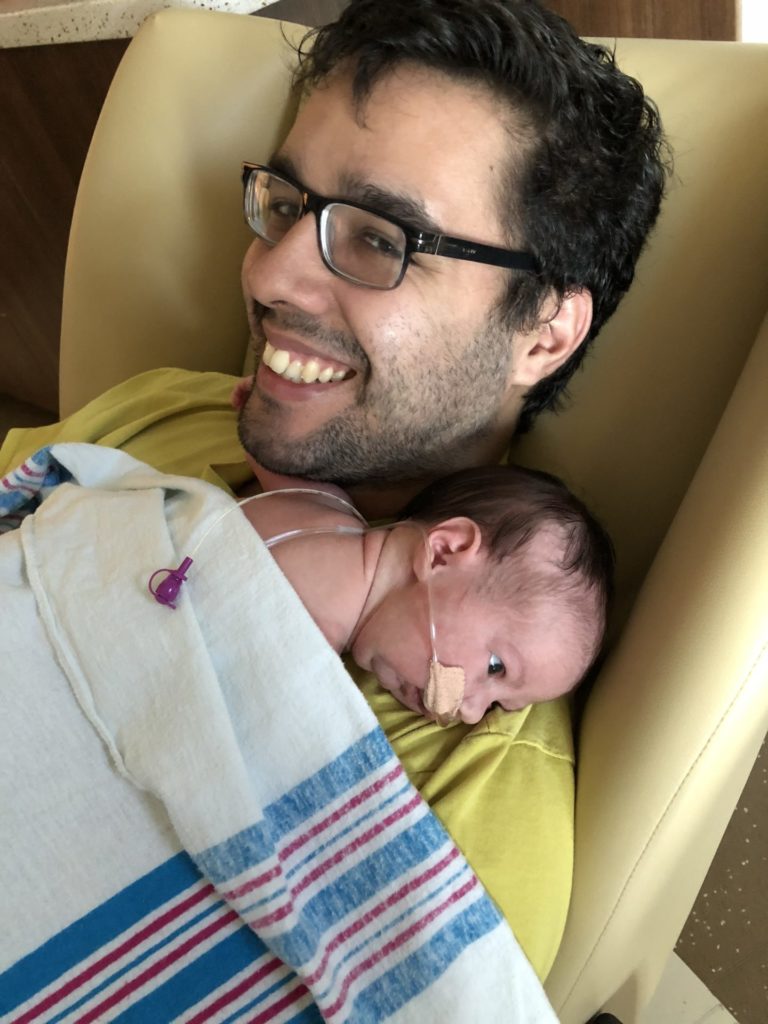
Even so, Josie often managed to shift and wiggle into a position that became dangerous for her. Her oxygen monitor would begin to beep loudly and her skin would turn dusky blue. It was the most terrifying period of my life, spending days in my daughter’s NICU room, waiting for the next alarm to sound. This happened so often that I was afraid the lack of oxygen would cause permanent brain damage.
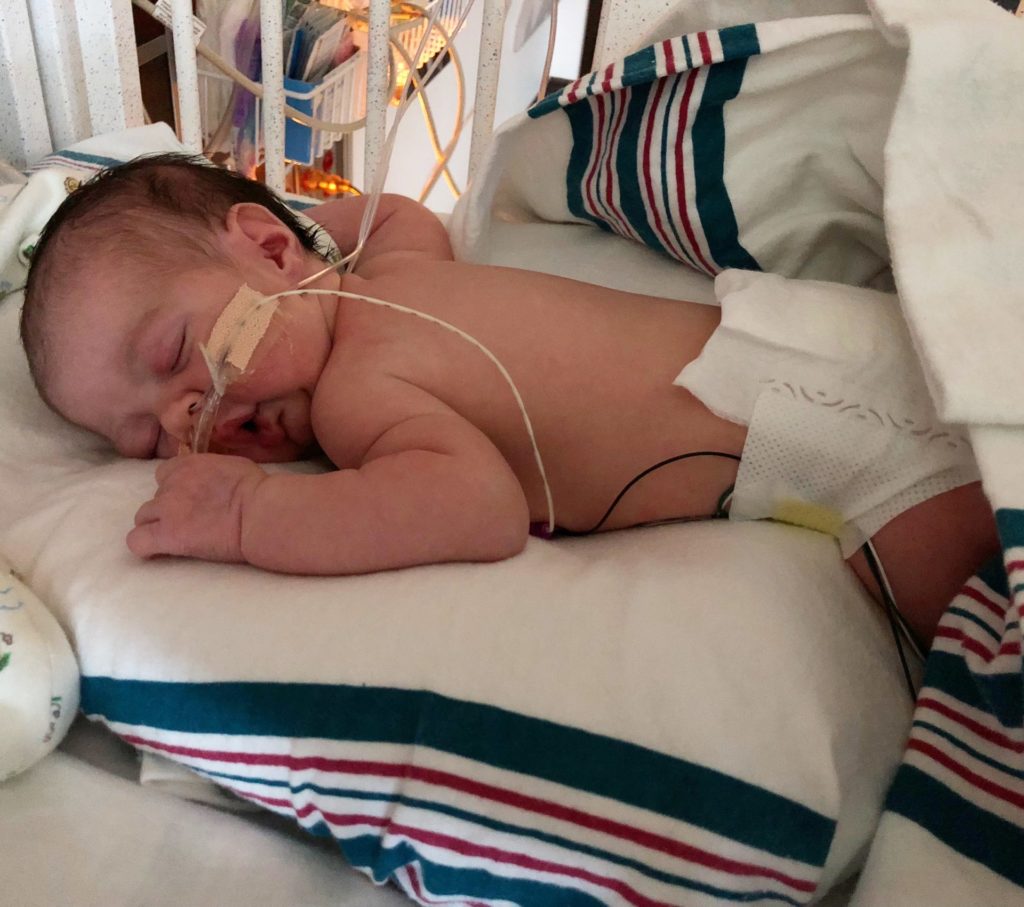
Eventually Josie’s desats became so long and frequent that her NICU doctors gave her a nasal cannula. This was a tube that fed into her nostrils that provided an extra boost of airflow. I truly felt like a burden was lifted when she got put on this supplemental oxygen. Every minute I spent away from the hospital, I worried that Josie would desat and the nurses wouldn’t get to her in time. So the supplemental oxygen gave me the tiniest bit of relief.
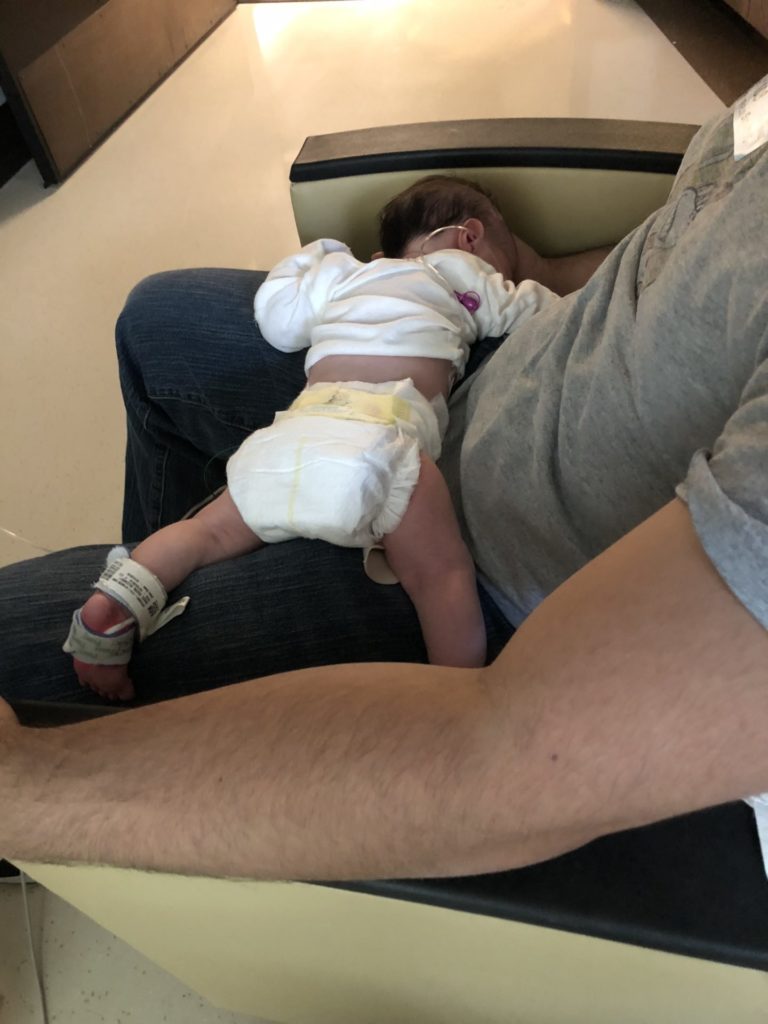
At this point, Josie’s wonderful occupational therapist got creative and built a “nest” for her out of positioning aids, rolled-up receiving blankets, and swaddles. I’ll add a few pictures of it so you can see what it looked like. It really helped keep her head angled in such a way that her tongue would fall forward instead of backward. I think it was more comfortable for her too.
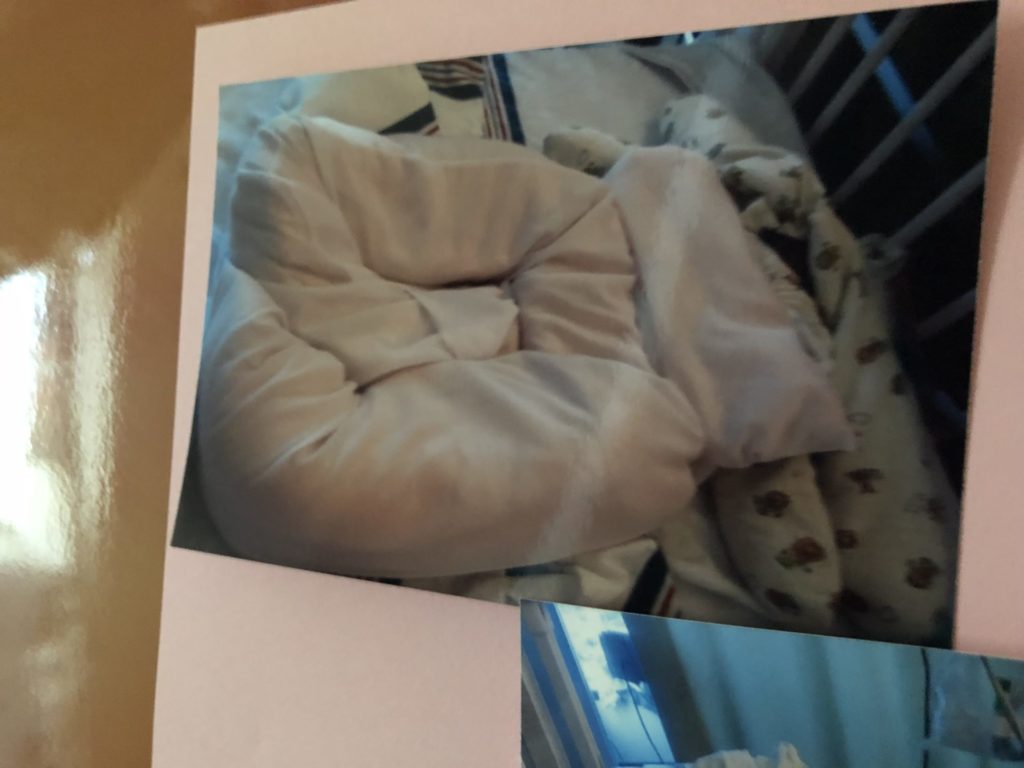
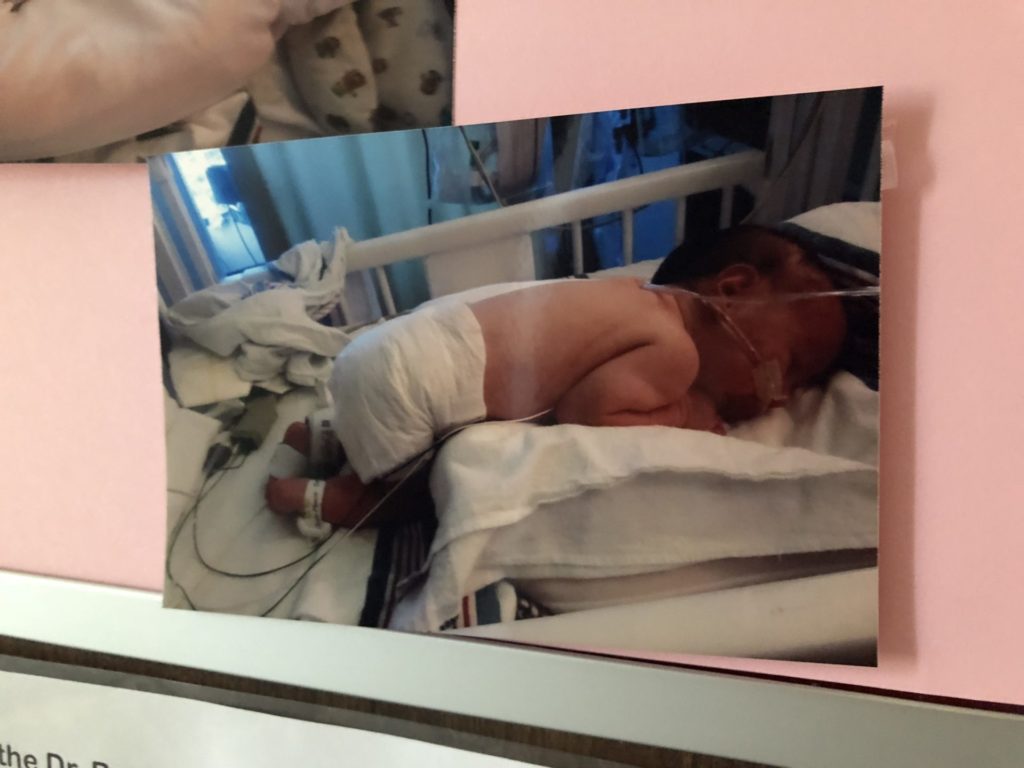
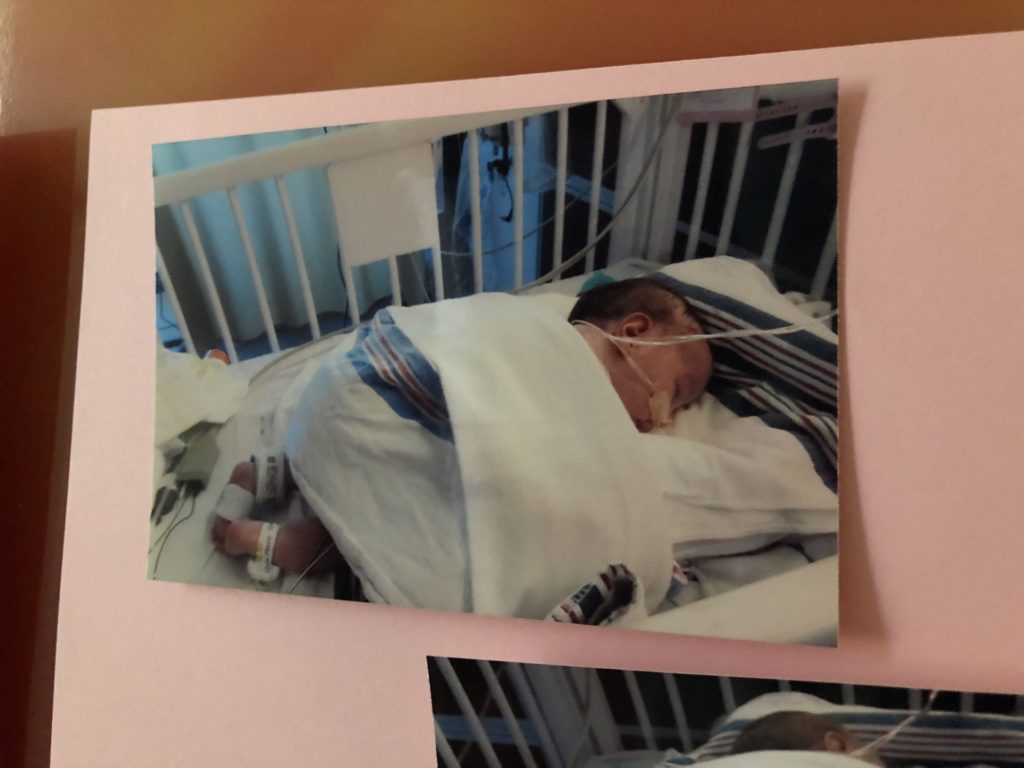
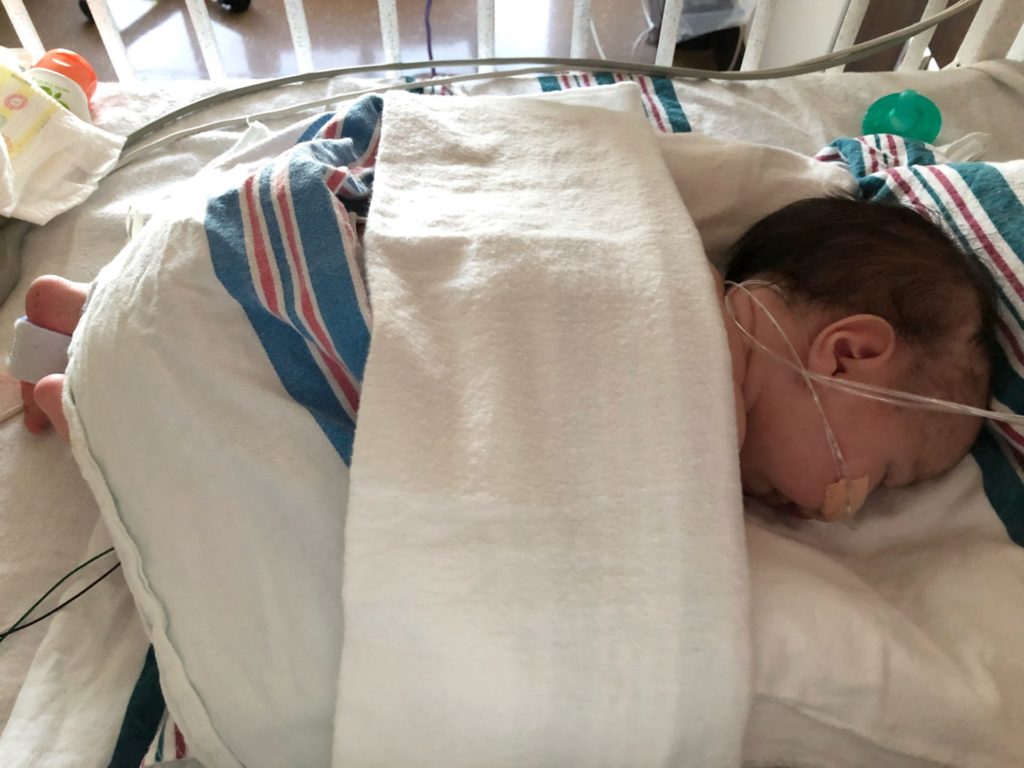
Before Distraction – Feeding
During this time, Josie was mostly fed my pumped breast milk through a nasogastric (NG) tube. This was a tube that went through Josie’s nostril and traveled directly to her stomach. She needed this tube because she couldn’t form suction to nurse or drink from a normal bottle due to her cleft palate.
Not that we never gave her a bottle! In fact, a speech therapist visited Josie every day, and helped her learn to drink from a special bottle (Dr. Brown’s specialty feeding bottle). The speech therapist also taught my husband and I how to feed her with the bottle, because Josie couldn’t be fed like most other infants. We had to hold her sideways during feeds, so that her tongue wouldn’t fall back and block her airway. Sometimes this happened anyway and she would turn blue while feeding. It was very scary.
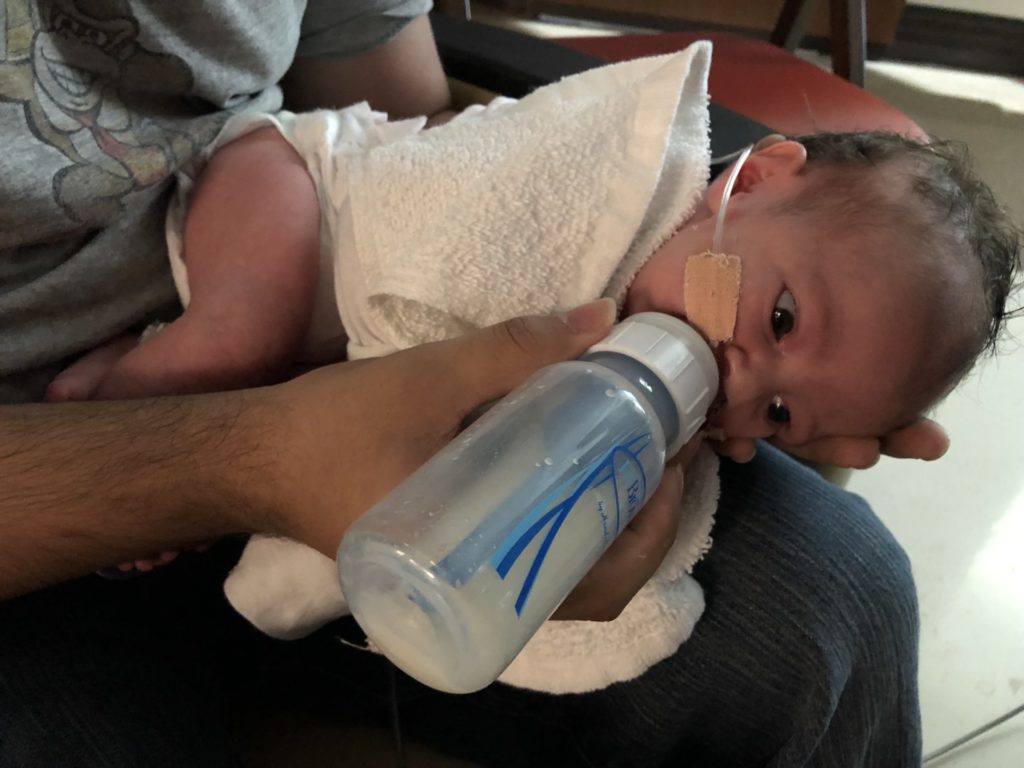
When she started learning to drink from the bottle, Josie could only take a few milliliters by mouth. The effort it took for her to get the milk out of the bottle would pretty much cancel out the calories she had just consumed. She lost a lot of weight after she was born, and it took almost 3 weeks for her to get back to her birth weight.
I pumped breastmilk for Josie 8 times a day, but when the doctors deemed it necessary to give her supplemental formula for an extra calorie boost, I had no problem with that.
Before Distraction – Testing
Also I just wanted to mention that Josie had a series of tests done during the time before surgery.
An ophthalmologist examined her eyes, and said that her vision seemed normal. However, he couldn’t look at her entire eyeball due to Josie’s very particular positioning requirements. It’s hard to look at somebody’s eyes when they have to be flat on their belly to breathe!
But overall, the test results seemed to indicate that Josie didn’t have Stickler syndrome. This syndrome commonly occurs with Pierre Robin Sequence. A big part of Stickler syndrome is often eye abnormalities.
Josie’s genetics team also ran a few tests on her, and found no indication of any well-known syndromes associated with PRS.
During Jaw Distraction
Josie underwent mandibular distraction (jaw distraction) surgery when she was 28 days old. Her surgeon wanted to wait as long as possible to allow her to grow as much as possible before surgery. She had really small jaw bones, after all, and those bones had to be cut and have hardware attached!
As I discussed earlier, the surgeon essentially broke Josie’s jaw on each side, then attached hardware to the bone that would gradually move her jaw forward. Two rods stuck out from her chin, and these were the screws that the doctor would turn each day to move Josie’s jaw forward. As her jaw moved forward, her body would generate new bone tissue to fill the gap. It was a slow and gradual process.
The hardware would stay attached to Josie’s jaw for about 4 months to allow the jaw to heal and solidify. Then her surgeon would perform another operation to remove the hardware.
Because of the rods sticking out of Josie’s chin, she had to be positioned on her back after surgery. (No more tummy sleeping!) Lying on her back would lead to obvious breathing problems, so the doctors put Josie on a ventilator for several days, along with sedatives and strong pain meds.
This was another difficult time for my husband and me. We couldn’t really touch or interact with Josie very much. We couldn’t hold her and I was petrified that I would accidentally bump the rods and ruin everything. I just had to sit by helplessly and wait.
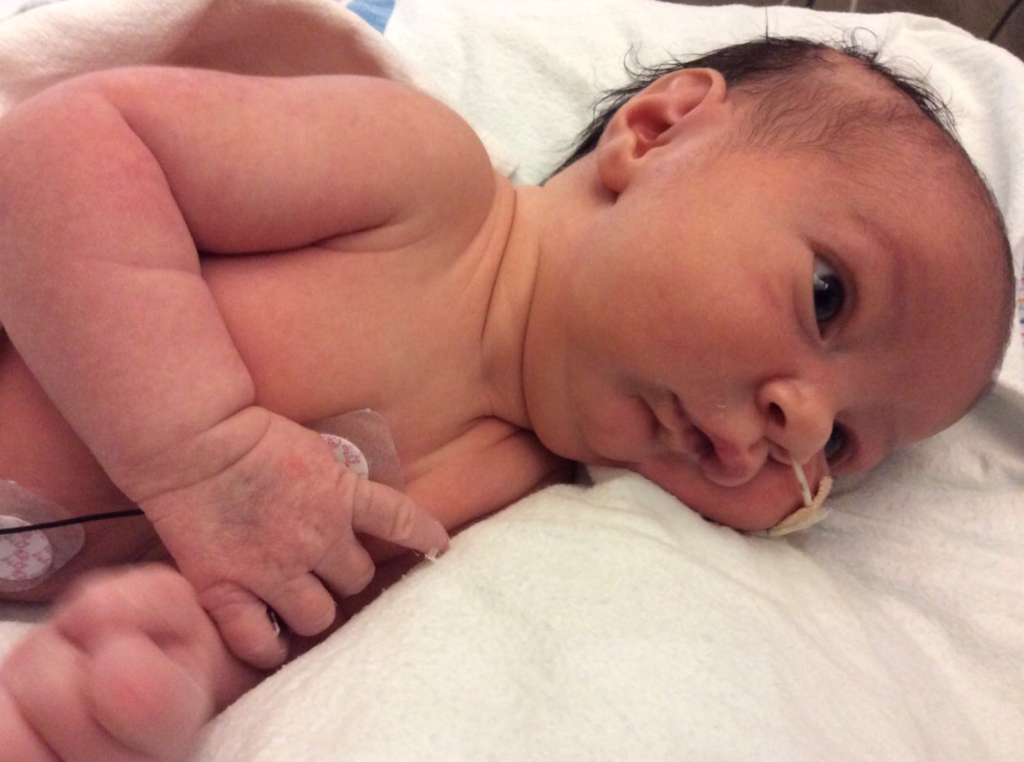
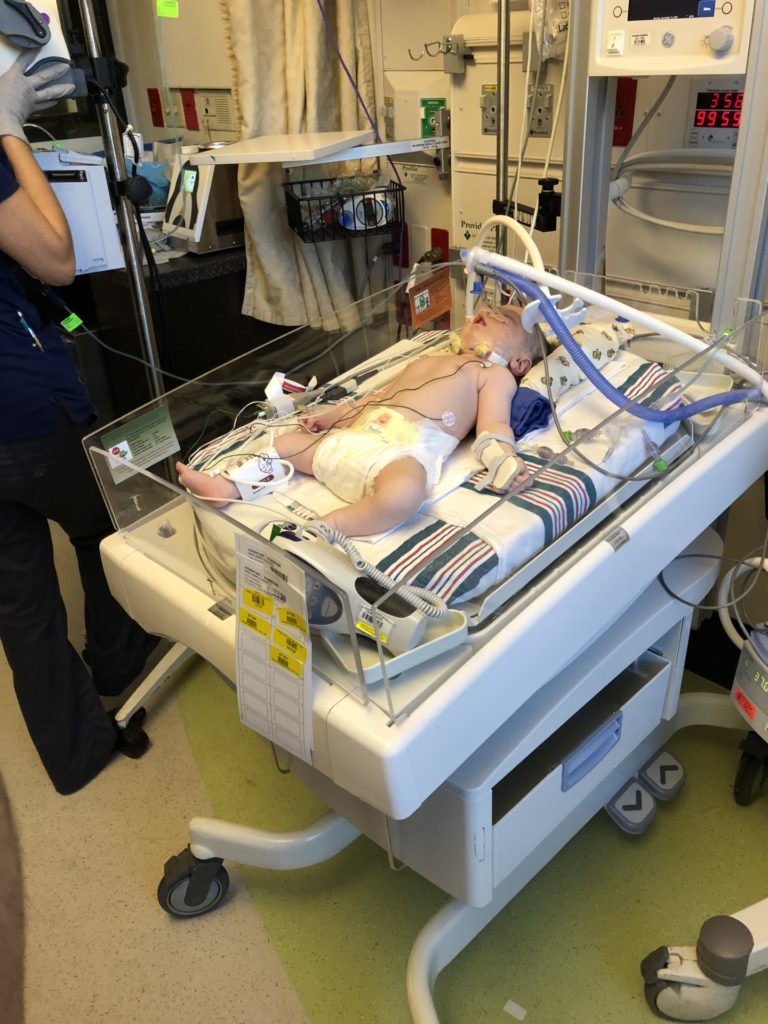
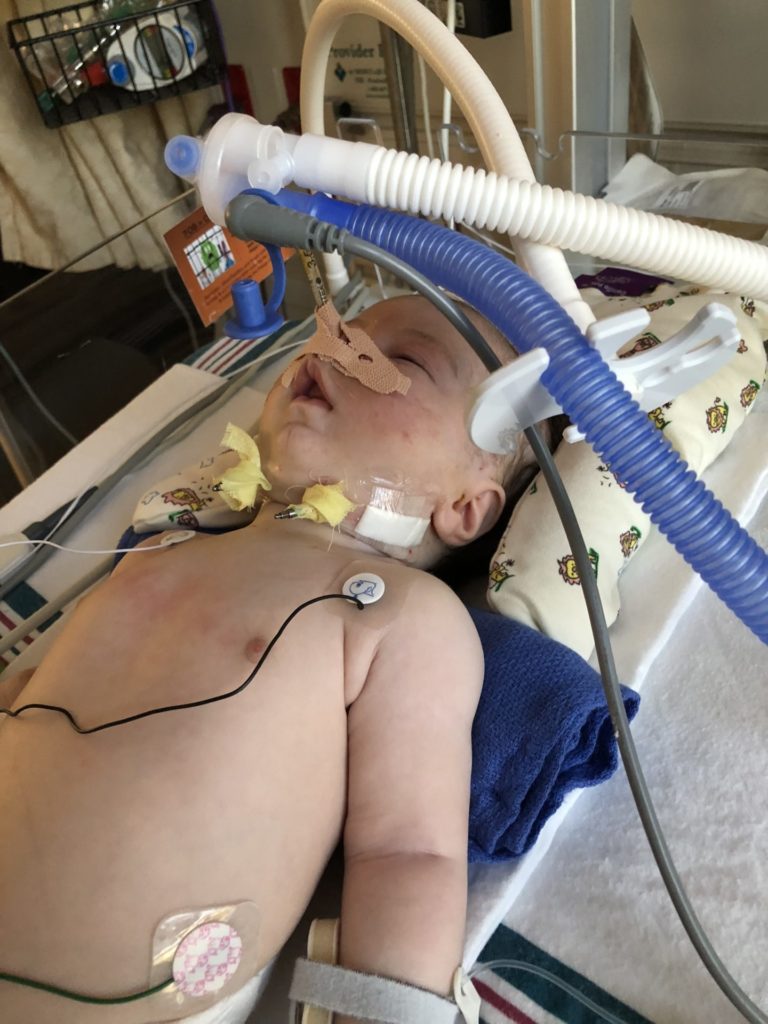
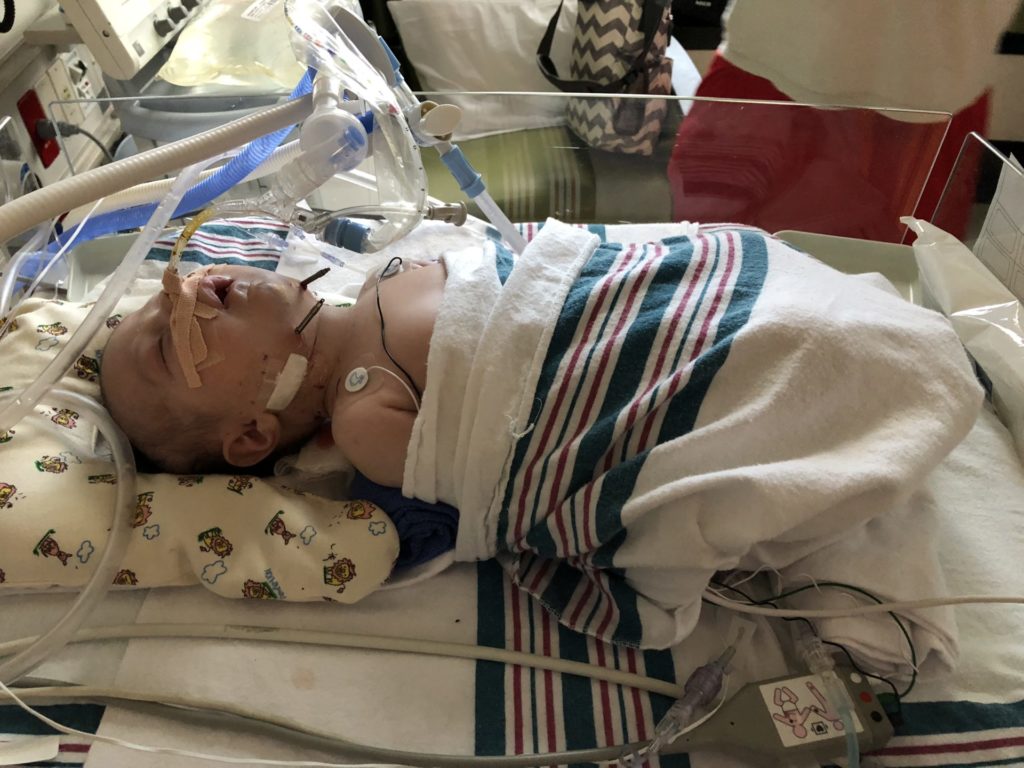
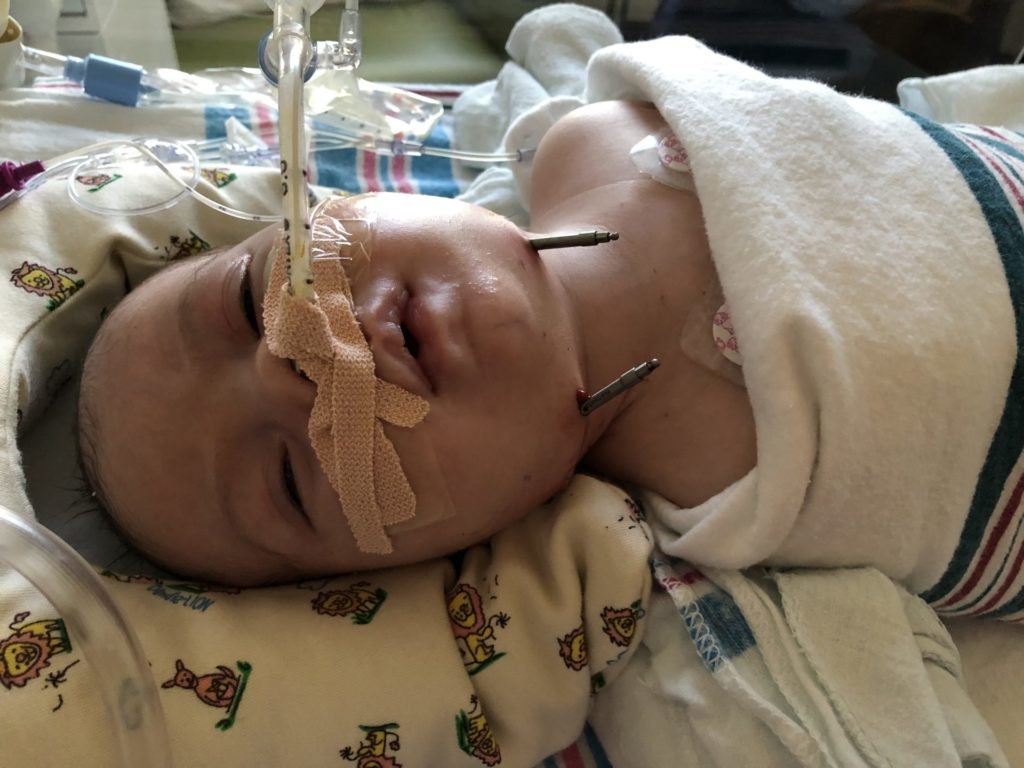
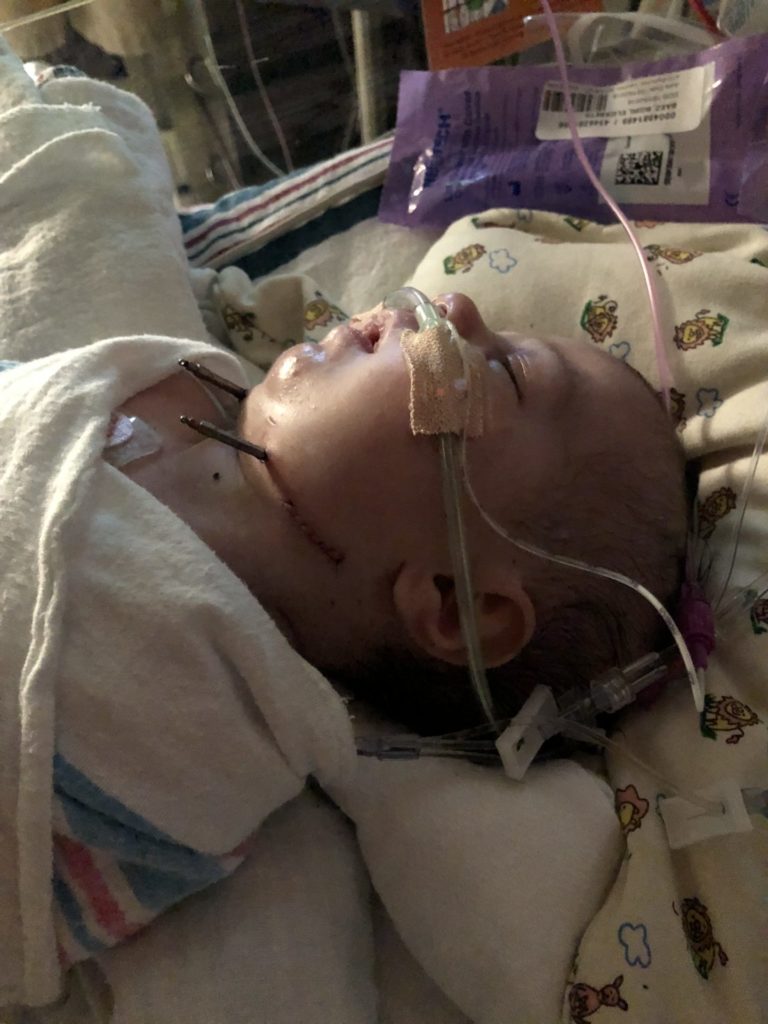
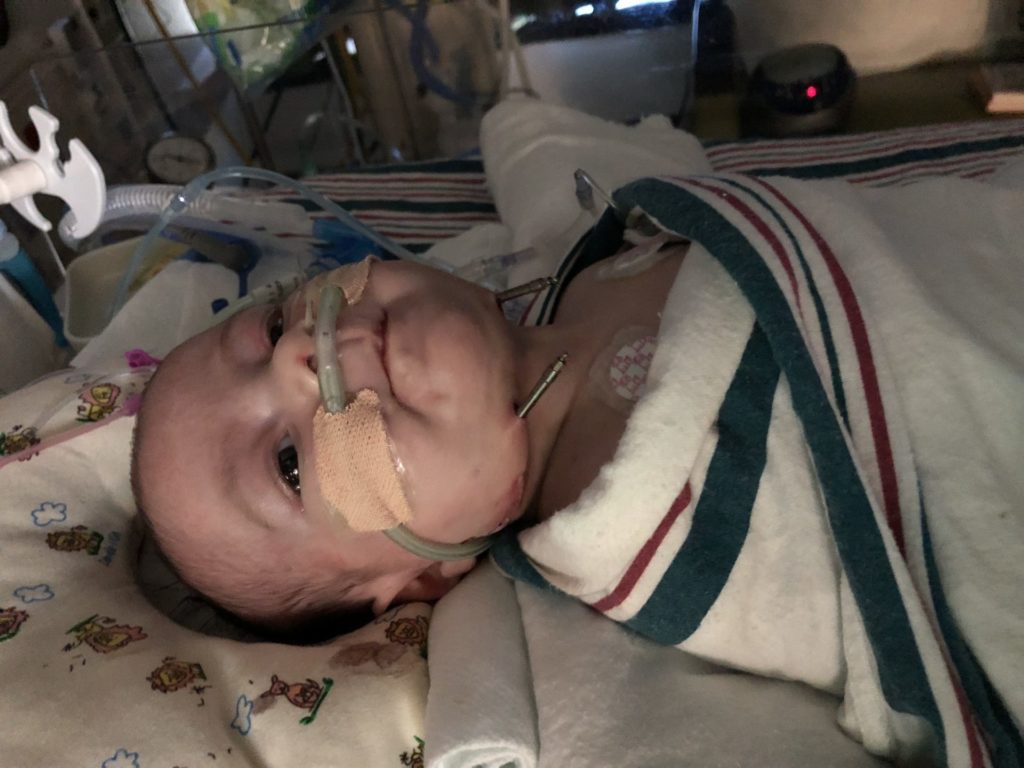
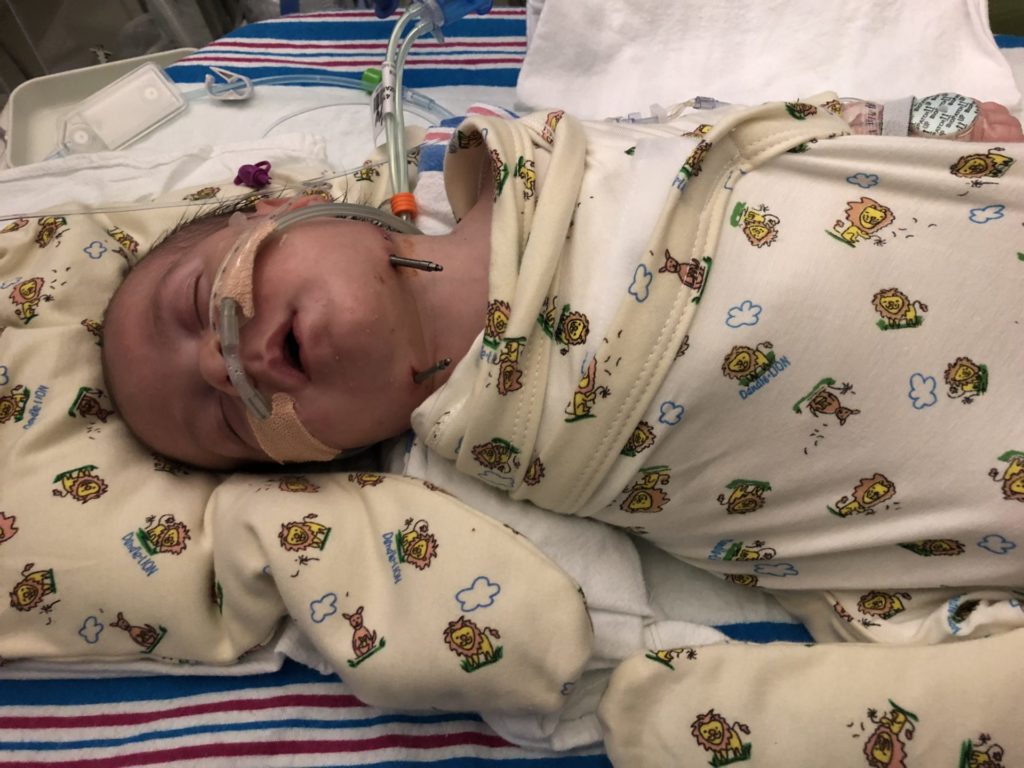
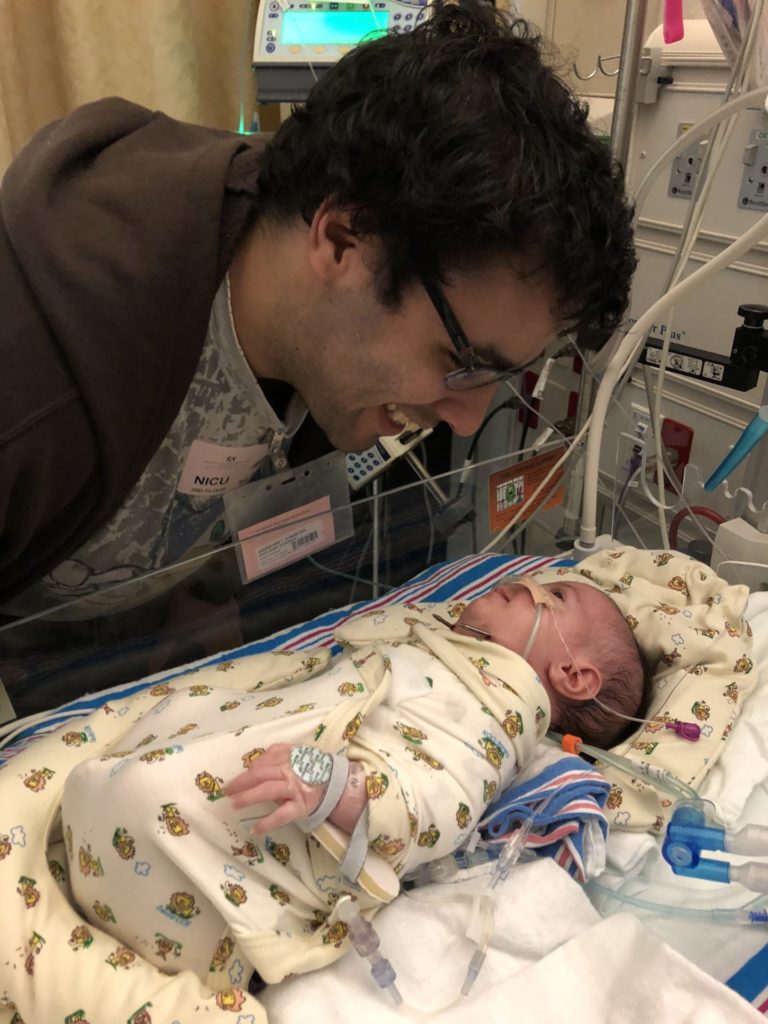
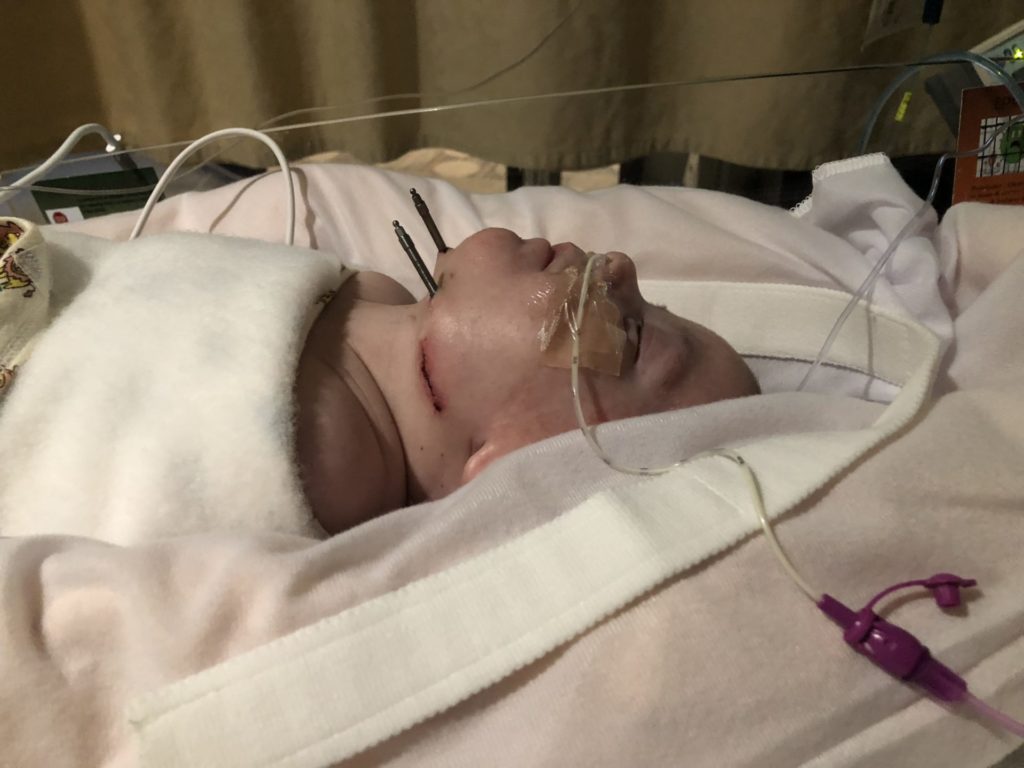
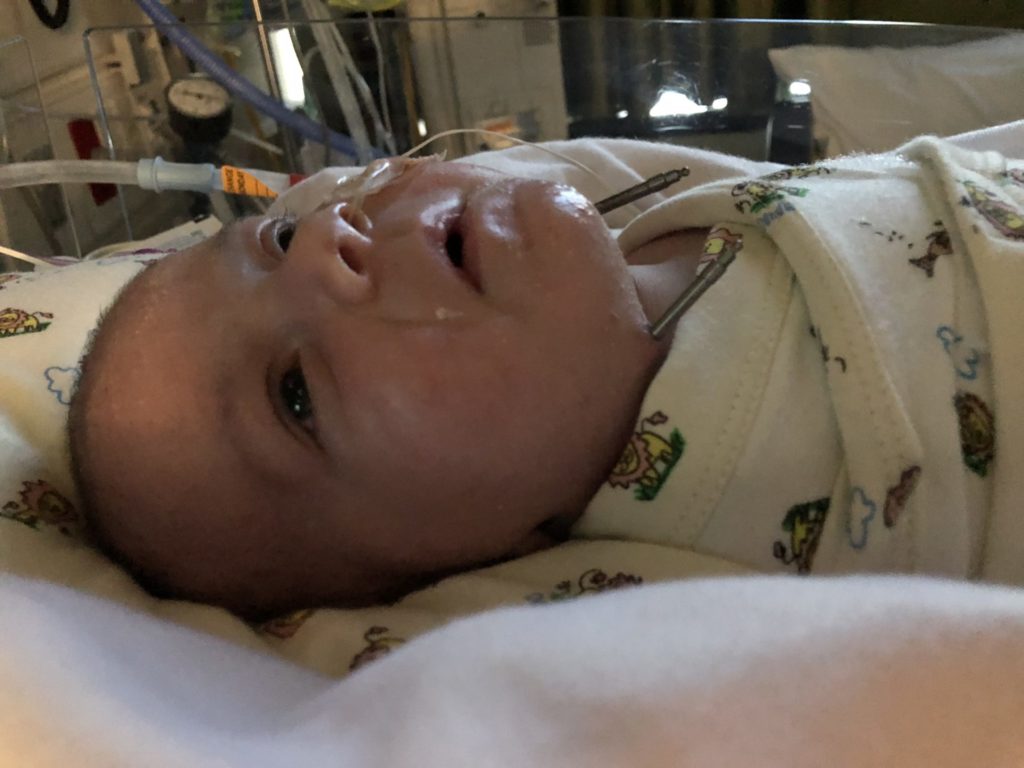
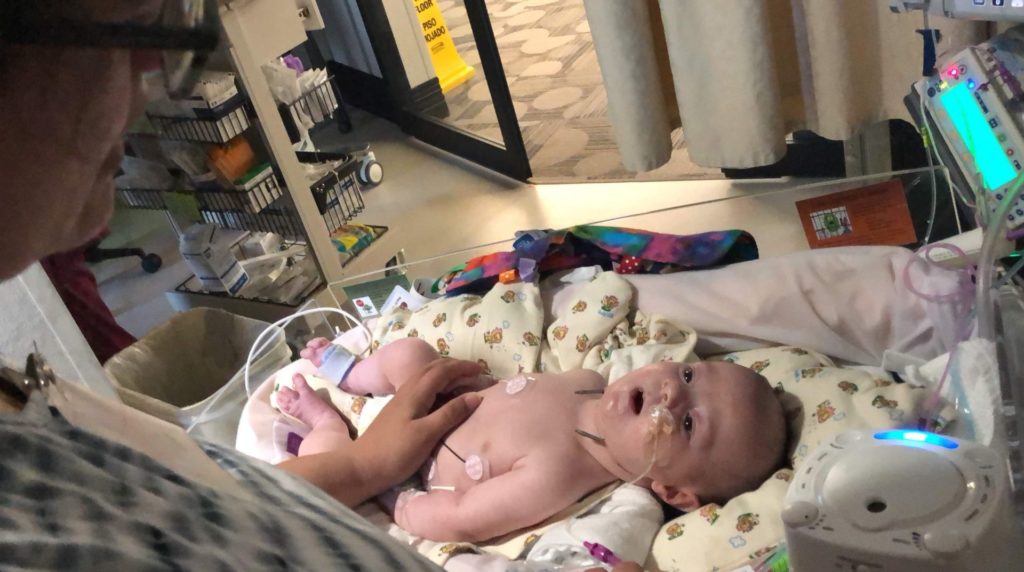

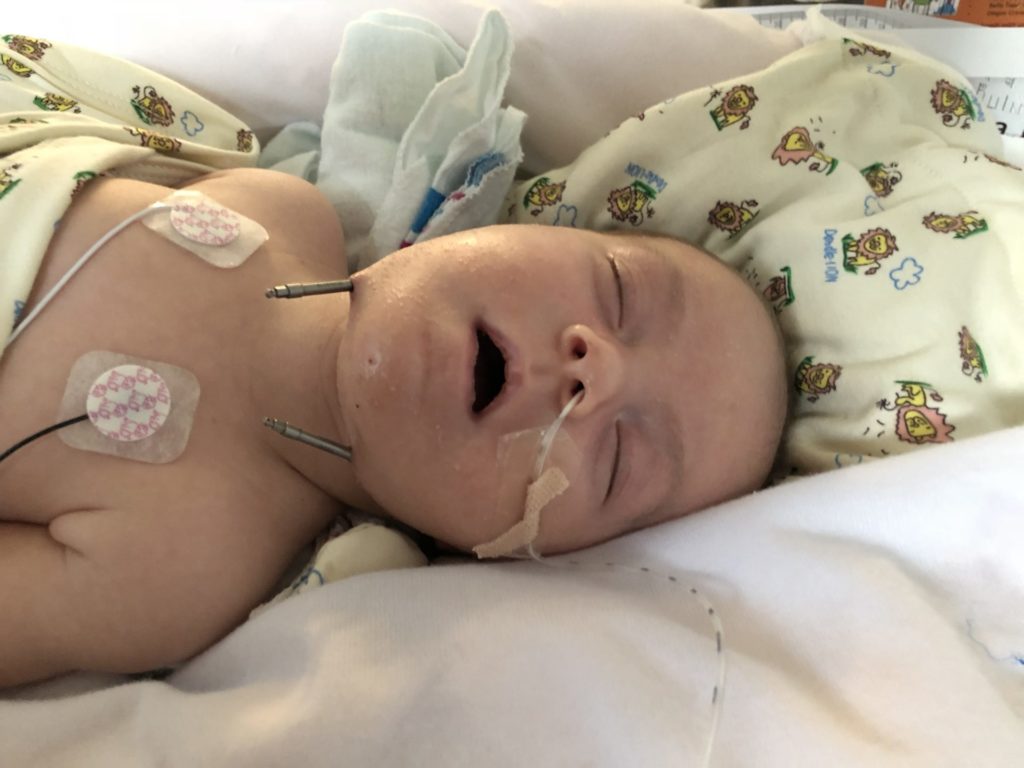
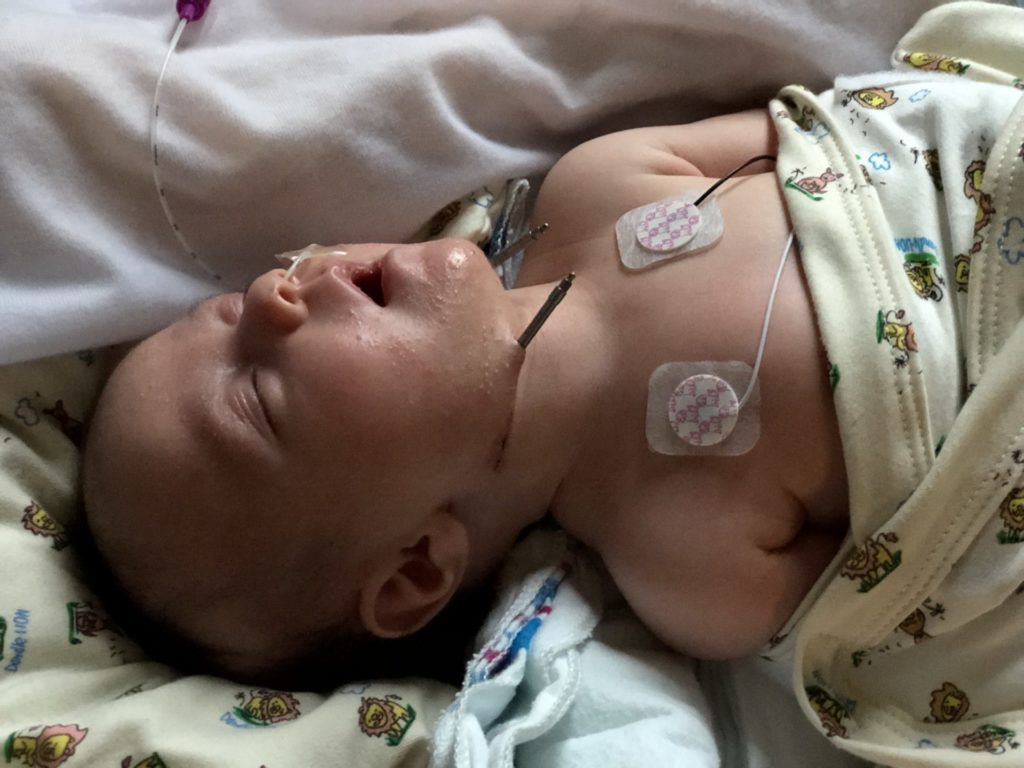
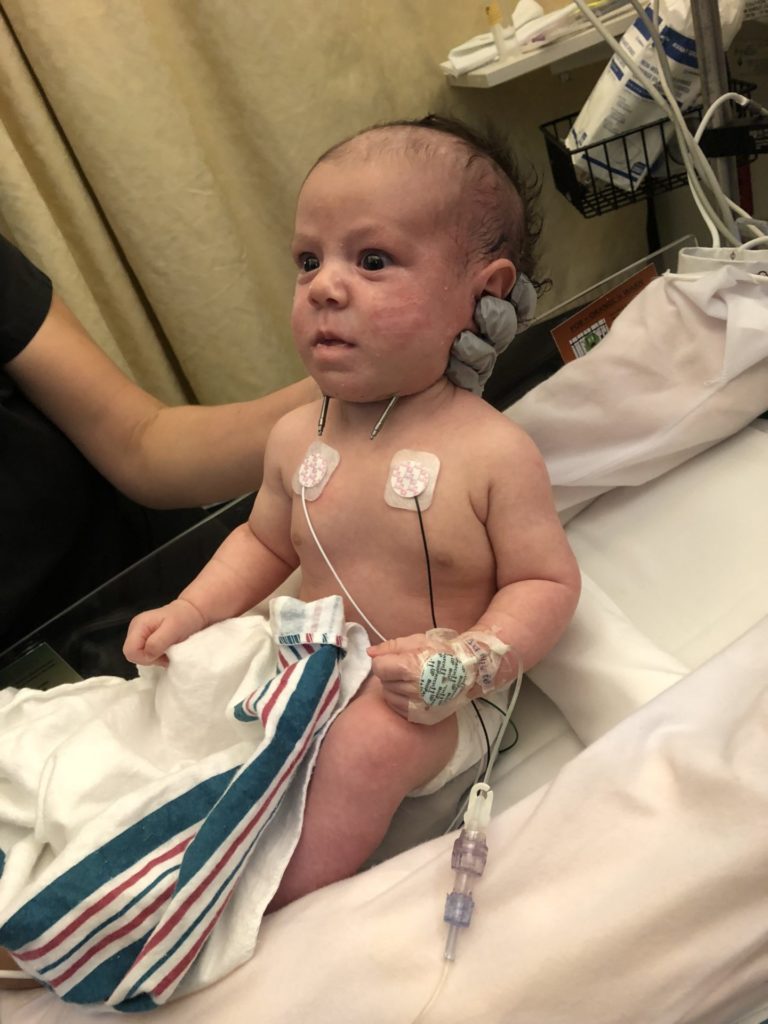
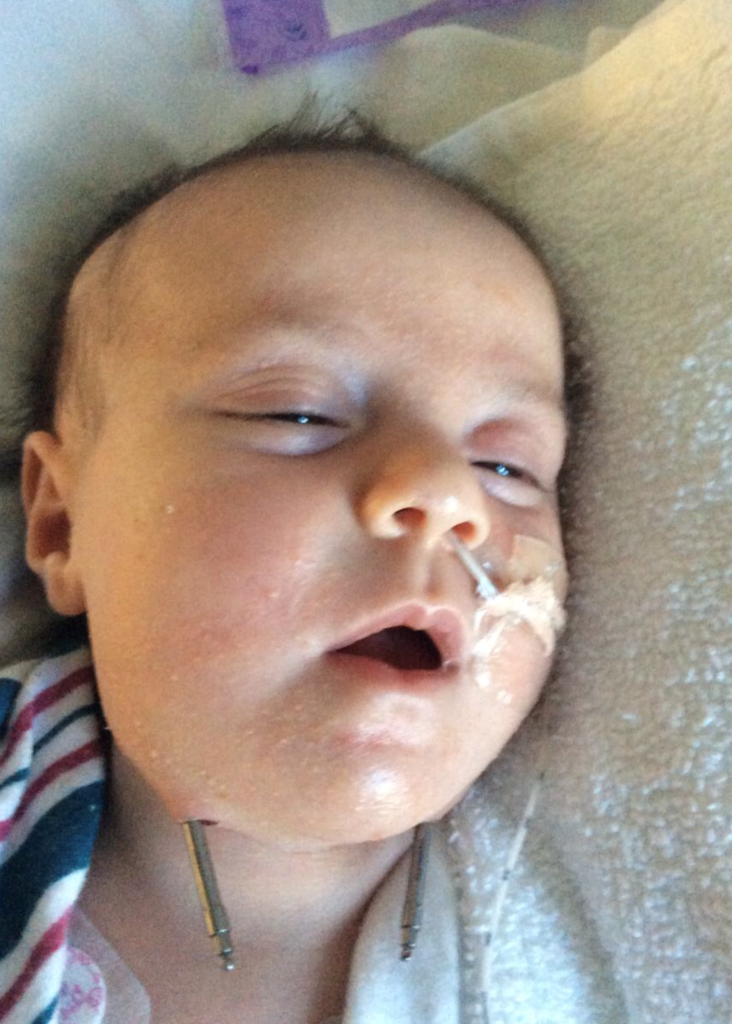
After Jaw Distraction – Transformation
Finally, after several days of her doctors turning the screws, Josie was eventually able to come off the ventilator. To my amazement, she could actually breathe while positioned on her back. No desats. No nasal cannula needed. It was so incredible to witness.
What was almost as astounding to watch was Josie’s physical transformation. Every day, Josie looked different than the day before, as her surgeon brought her jaw forward more and more. Sometimes it was hard to believe that she was even the same baby with the tiny chin that I gave birth to. The whole distraction process took about 12 days, and by the end I had a brand new baby with a big ol’ chin!
After the removal of her rods, Josie could sleep in any position! It was so amazing. Her surgeon no longer wanted her to have a pacifier at this point. He said the constant sucking motion could cause tiny movements in her hardware. He also said that it could possibly widen her cleft. So we ditched the pacifier, which wasn’t an easy feat!
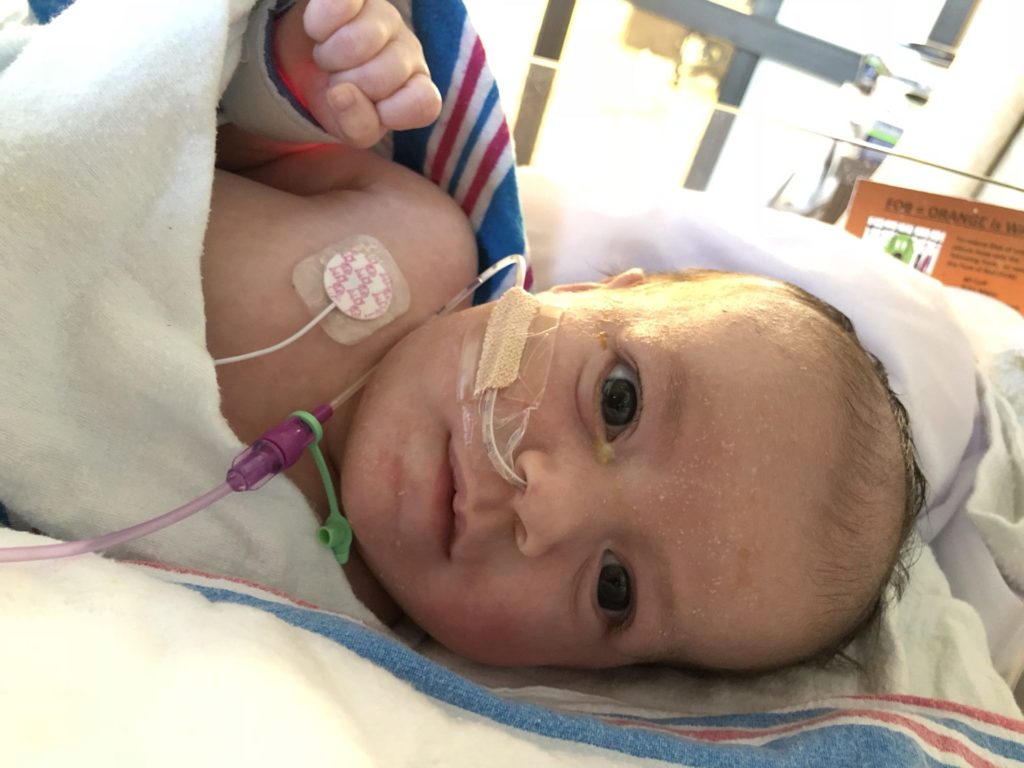
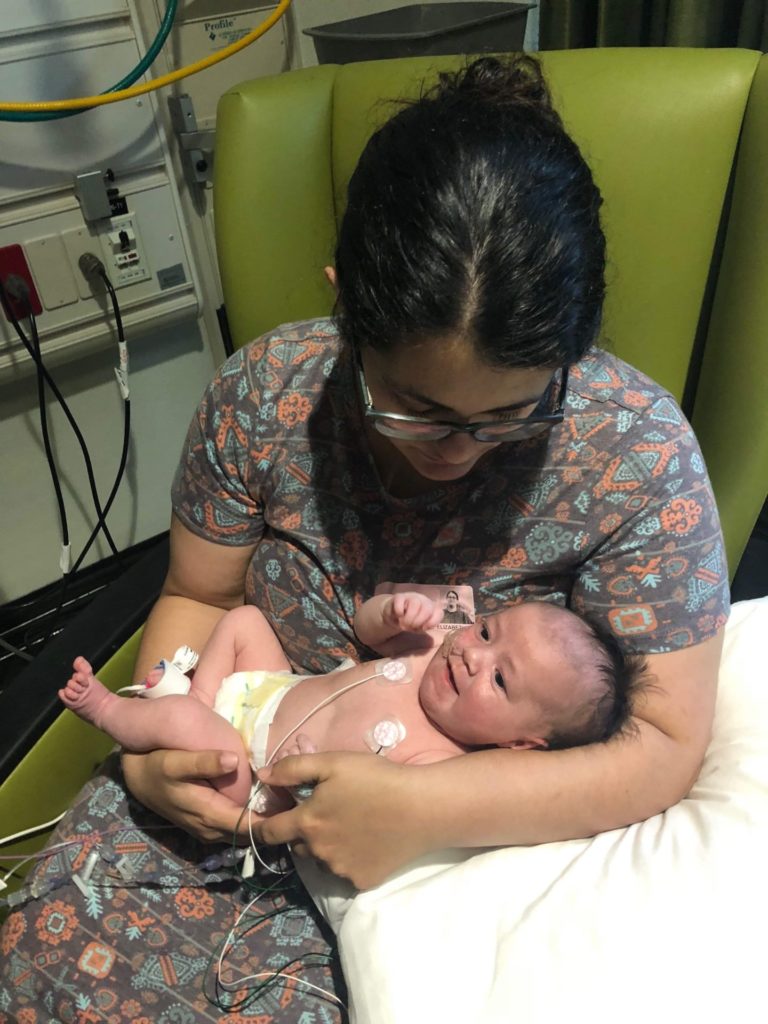
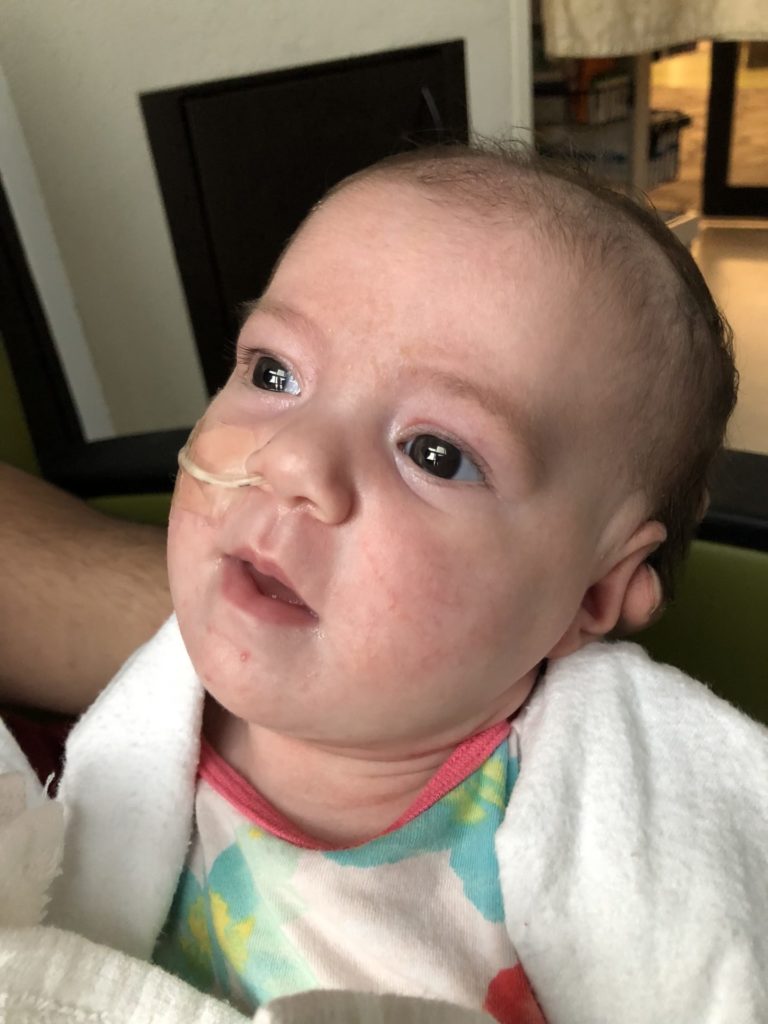
After Distraction – Problems
After distraction, 2 main issues cropped up. The first and biggest issue was that one of Josie’s surgery sites became red and inflamed, with some pus inside. Her doctors were worried about infection entering her freshly cut bone. Bone infection is no joke. Even if she was treated with antibiotics, they worried that bacteria would still live on the hardware that was attached to her bones. If the antibiotics were stopped while Josie still had her hardware, the doctors were concerned that any bacteria living on the metal pieces could infect her bones.
So, as a preventative measure, an infectious disease doctor prescribed 2 antibiotics that Josie had to take until her hardware was removed, almost 4 months later. This long-term antibiotic use created a LOT of stress for our family. I felt a huge amount of pressure to keep pumping to provide Josie with the benefits of breast milk and to hopefully counteract any negative effects of the antibiotics. Long story short, those antibiotics led to one of the worst periods of depression and anxiety in my life. Maybe I’ll talk more about that in another post, but that’s not why we’re here today.
The second issue that occurred after surgery was that Josie developed small bumps all over her face. The hospital cultured some bacteria from the bumps and didn’t find anything to concern them. It just seemed like baby acne. Eventually it went away on its own.
After Distraction – Feeding
At this point, all Josie had to do was learn to take full feeds by mouth, without the help of her NG tube. Easier said than done.
We practiced feeding her with her special bottle multiple times a day. It became an obsession for my husband and I. When we arrived at the hospital each day, our first question for Josie’s nurse was, “How many ounces has she had today?” (This was a much better question than, “How many desats has she had today?” But I digress…) We were just so impatient to take our baby home.
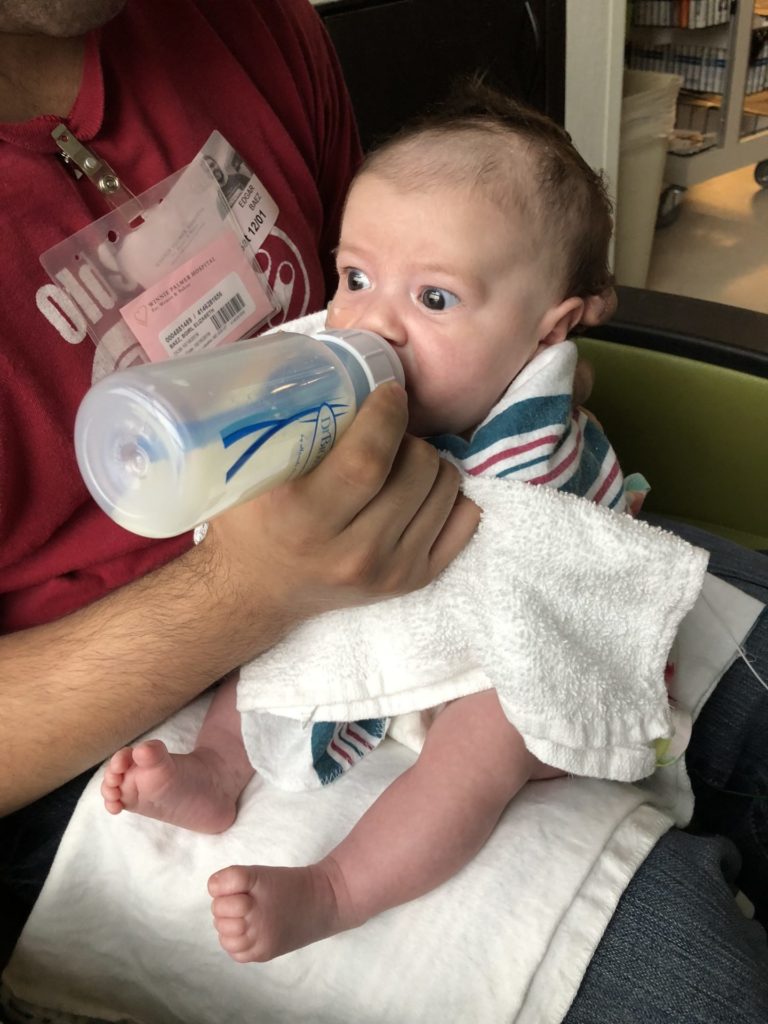
As the days dragged on, Josie was gradually able to take more and more milk from the bottle. At last, 16 days after the rods were removed – and 56 long days after Josie’s birth – Josie’s doctors decided she could handle life in the real world. Bye bye, NICU!!!!
Josie’s Teeth
I also wanted to throw this in here, because it might be relevant to some of you. Josie’s first tooth erupted at 5.5 months. Her second tooth didn’t show up until around 12 months. Now at almost 16 months she has 7 teeth. They don’t seem to have any crazy issues yet but we are planning to take her to a pediatric dentist in a few weeks to have everything checked out.
Josie’s craniofacial surgeon told us that the distraction may affect her molars, because he cut her jaw in the back where the molars are located. This cutting may have damaged the tooth buds (essentially the cells that would eventually become her teeth). We just have to wait and see! But I’ll take a breathing, healthy child with damaged teeth over a baby who turns blue from lack of oxygen ANY day.
So that’s our experience with Josie’s mandibular distraction in a nutshell. I’ll provide a couple links to great resources below because it’s a hard process to explain without pictures, diagrams, and a medical degree! But hopefully you got the gist of it, particularly the emotional side of the whole thing. If you have any questions feel free to leave them in a comment!
The Royal Children’s Hospital Melbourne – Jaw distraction surgery (mandibular distraction)
Children’s Minnesota – What is mandibular distraction?
Elizabeth From Scratch is a participant in the Amazon Services LLC Associates Program, an affiliate advertising program designed to provide a means for sites to earn advertising fees by advertising and linking to Amazon.com.
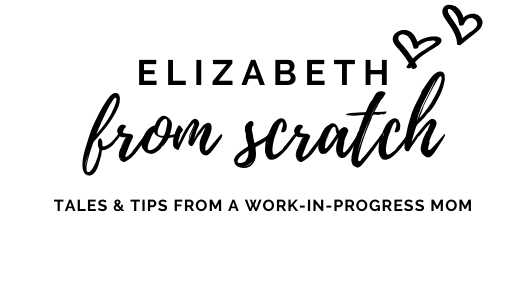
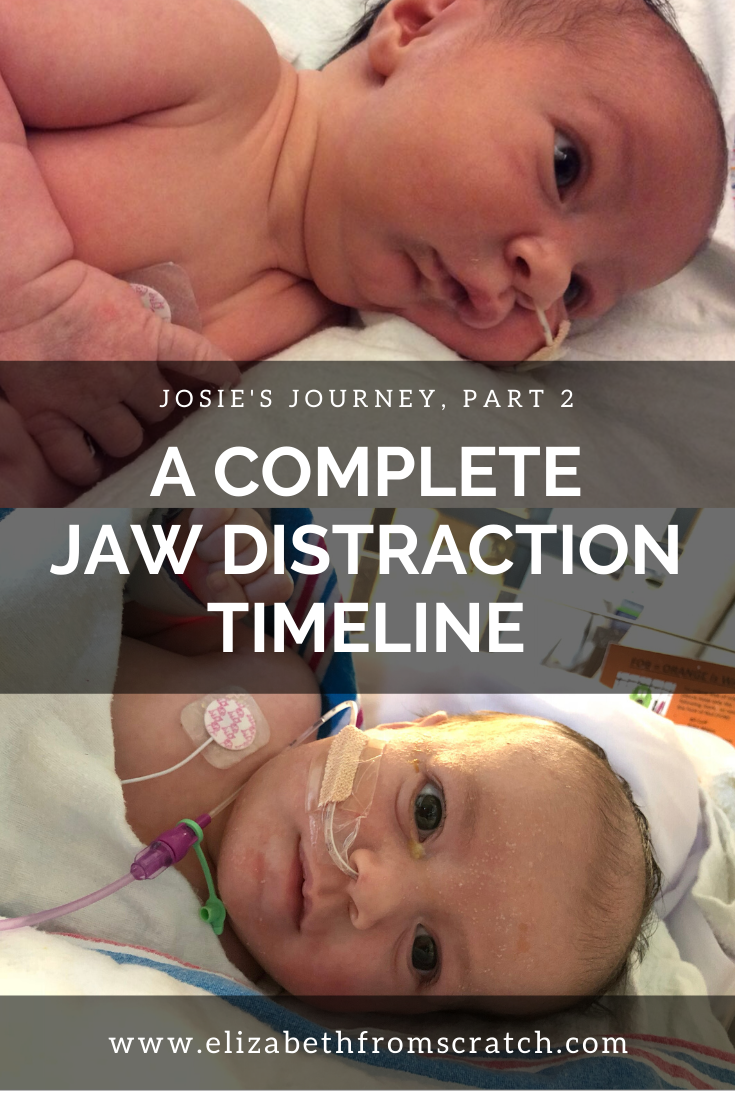


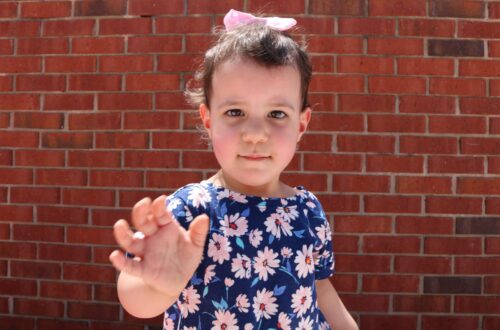
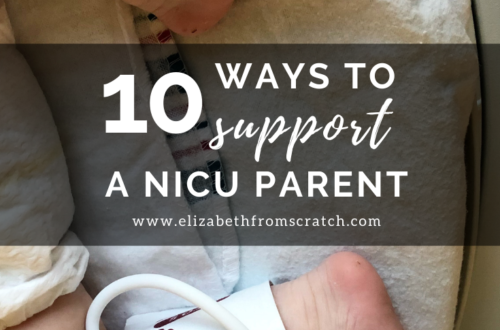
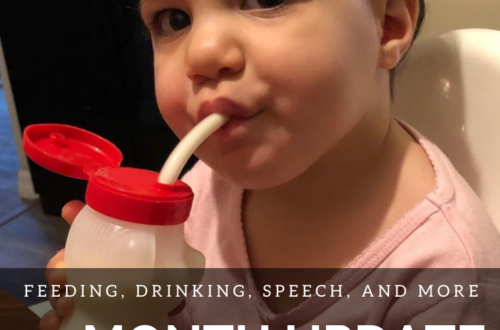
2 Comments
Julia
I cannot thank you enough for this post. I’m 21 weeks and my baby was just diagnosed with Pierre Robin syndrome. We’re visiting with doctors in preparation for an assisted delivery to ensure that our son receives adequate oxygen, and the entire post-birth process they described to us aligns with Josie’s journey precisely. Reading through this post and Part 1 brought tears of relief to my eyes – showing a small window into your heroic journey and Josie’s extraordinary path to better health. From one (almost) mother across the world, sending love and support and gratitude.
Elizabeth
Hi Julia! Thank you so much for your comment. I hope you and your family are doing well. Please feel free to reach out to me if you have any questions at all. You can also find me on Instagram (@elizabethfromscratch) and I’m much more responsive on there if you ever need someone to chat with! 🙂